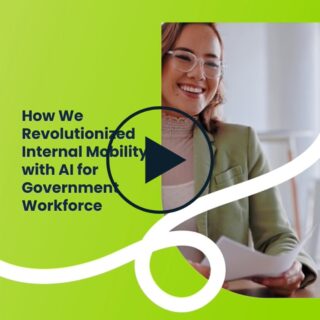Unconscious bias affects us all. In the two years since the death of George Floyd, public consciousness around the issues of diversity, equity and inclusion has risen throughout the globe. As such, employers can no longer remain silent.
In this episode of our Talking Talent podcast, we hear from Simon Wright, Global Head of Talent Advisory, about tactics to reduce unconscious bias and make your recruitment process more inclusive.
Not only are investors and shareholders paying greater attention to social challenges, but employees, candidates, and consumers are also pushing businesses to make public commitments regarding diversity and inclusion—and to publish their progress. In today’s job market, where job vacancies are outpacing unemployment, candidates have more choices than ever about where to work—and they’re choosing employers that prioritize DE&I: According to Glassdoor, 76% of candidates said that a diverse workforce was an important factor when evaluating companies and job offers.
Unconscious bias is one of the key forces holding employers back from making strides in DE&I initiatives, and it’s a complicated issue to tackle. In this article, we’ll walk through the different types of unconscious bias, how they can affect your recruitment process and how to effectively reduce their effect.
What is Unconscious Bias?

Unconscious bias—sometimes called implicit bias—is a term that describes the associations we hold outside of our conscious awareness. Everyone has them, and they don’t make you a bad person; they’re an evolutionary adaptation designed to help our brains make decisions.
Imagine if, every time we made a decision, we had to consciously take into account every piece of information available to us. Unconscious bias develops from our life experiences to help us navigate the world more quickly. However, it can also have negative consequences. And, the fact that it happens unconsciously means it can be difficult to bypass.
For instance, in action, unconscious bias can look like what happened in the Boston Symphony in 1952. The Symphony was looking to diversify its male-dominated orchestra, so it conducted an experiment with a series of blind auditions. In an effort to remove all chance of bias and allow for a merit-based selection only—a selection that would hopefully increase the number of women in the orchestra—the musicians would be auditioning from behind a screen. To their surprise, the initial audition results still skewed male. Then, they asked the musicians to take off their shoes. The reason? The sound of the women’s heels as they entered the audition unknowingly influenced the adjudicators; once the musicians removed their shoes, almost 50% of the women made it past the first audition.
This is just one example. There are several different types of unconscious bias that affect our decision-making:
Confirmation Bias
Confirmation bias causes us to seek out information that confirms something that we already believe. We hear about this type of bias most often in relation to politics. People are more likely to seek out positive news about the candidate they support, reenforcing their belief that they are supporting the right person. It can also play out in the hiring process. Recruiters and hiring managers can make snap decisions about candidates based on perceived truths. Then, they ask questions to try to justify these biases, rather than evaluate each candidate on the same criteria.
Affect Heuristics
Affect heuristics are mental shortcuts we take to make decisions based on our emotional or mental state, rather than taking all of the facts into account. In the recruitment process, this could play out with a recruiter or hiring manager discounting a candidate because of personal feelings that have nothing to do with the role. For example, if you used to have a friend named Pete, who you fell out with, you might still carry a negative bias toward a candidate named Pete.
Anchor/Expectation Bias
An anchor or expectation bias happens when we allow ourselves to anchor on to one piece of information to make a decision. This can happen in the hiring process when a hiring manager believes that a new hire needs to be a carbon copy of the person who used to have that role, so they anchor on one aspect of a candidate that is similar to the previous employee and ignore other information.
Halo Effect
The halo effect is a bias that causes us to use a general positive impression of someone to influence how we evaluate their specific attributes. For example, if we’re impressed by one fact about a person (like if they went to a prestigious university), that could make us see them in a generally positive light. The halo effect often kicks in when we wish we were more like another person. This plays out in the hiring process when a hiring manager or recruiter focuses heavily on one positive aspect of a candidate’s background and lets that guide their opinion moving forward.
Horn Effect
The horn effect is the opposite of the halo effect; it happens when we let one perceived negative aspect of a person influence the way we think about them. For instance, something as simple as not liking a candidate’s outfit or the way they speak can cloud a recruiter’s or hiring manger’s judgment during the recruitment process and be difficult to get past.
Affinity Bias
The affinity bias causes us to connect with people who are similar to us. This is different from the halo effect because it happens when we identify a similarity with someone, rather than looking up to them. We like the feeling of affinity because it makes us feel connected and part of a community, and we also want to surround ourselves with people who we feel we have rapport with. In the hiring process, this can lead to teams with little cognitive diversity as recruiters and hiring mangers lean toward candidates similar to themselves.
Conformity Bias
In essence, conformity bias is peer pressure. It causes us to rely on the opinions of others when making decisions, rather than making an independent choice based on our own interpretation of the facts. This can kick in when making the hiring decision: If you’re on a panel and you think one candidate is really great, but the rest of the group prefers someone else, you could get swept along by the majority.
Contrast Effect/Judgement Bias
The contrast effect happens when we compare two similar things to each other, rather than assessing them independently. During the recruitment process, this can happen when a recruiter or hiring manager compares one résumé or CV to another they viewed before. In doing that, they shift the goal posts; instead of judging a candidate based on their suitability for the role, they make a decision based on what they thought of another candidate.
Combating Unconscious Bias

Understanding the different types of unconscious bias is only the first step toward reducing its influence on your organization. And, while training can raise awareness, it rarely changes behavior. So, to make a real change, employers should implement a robust diversity and inclusion program that touches every aspect of the hiring process. Following are some proven steps you can take to reduce bias.
1. Clearly Outline the Role
Taking time to really understand what the role requires is essential for weeding out bias in the recruitment process. Specifically, by identifying eight to 10 objective criteria that are predictive of role success, you’ll decrease the likelihood that decisions are made using unconscious bias. It’s important to evaluate what it takes to be successful in the role. Is there anything that could stop a candidate from applying? Does the role need to be performed in person or can it be done remotely? Are the criteria you’re using accurate predictors of success? Are you relying on the vague concept of “cultural fit” that breeds affinity bias?
As an example, some of the big four accounting firms have reduced their reliance on academic achievement for their early careers and campus hiring programs because they know it’s not an accurate predictor of future success in the role. Instead, they’re now focusing on potential by using other measures that they’ve tracked over time to show their effect on performance.
2. Build an Inclusive Job Description
Once you’ve outlined your role internally, focus on your external job description. Is there anything that could discourage a strong candidate from applying? In particular, remove gendered language from your job descriptions and check the pronouns you’re using. Additionally, avoid words like “expert,” “superior” or “rockstar” that turn off female candidates. A variety of online tools can help highlight and remove biased language.
Next, ensure that the requirements that you list for the role only cover what is absolutely necessary. Women are less likely than men to apply to a role if they don’t feel that they meet all of the requirements, whereas men are more likely to apply if they only meet a portion of them.
Finally, when creating a job description, ask multiple people from different backgrounds to review the job description—and take their feedback into account.
3. Update Your Screening Process
The next area to consider is your selection process. Are you relying too much on résumés and CVs? Research shows that CVs are not only fraught with bias, but that they’re also bad predictors of success. That’s because there are many factors on a CV that can trigger unconscious biases, like the person’s name (gender or ethnicity), the school they went to (geography or economic class) or the year they graduated (age).
For example, according to the National Centre for Social Research, people with white-sounding names are nearly twice as likely to get callbacks for jobs than people with ethnic-sounding names. In their study, job applicants with white-sounding names were a significant 74% more likely to be invited to a job interview compared to applicants with an ethnic/minority-sounding name.
4. Rethink Your Interviews
Recruiters and hiring managers often rely heavily on interviews, which can be rife with unconscious bias. On top of that, interviews have a predictive power of 56%, according to Don Moore, a professor at the University of California, Berkley. That means that, if you’re making your decision based on an interview, you’ll make the wrong decision nearly half of the time.
Plus, most interviews are conducted one-on-one or with small groups, where bias can flourish. However, mixed panels with diverse interviewers and objective criteria used to assess each candidate can lower the risk of bias when compared to traditional interview settings.
Meanwhile, there can be an increased risk for bias in the new world of virtual interviews, as well. That’s because, when interviewers can see the inside of a person’s home, they can make unfair assumptions. So, if you use video interviews, ask candidates to blur their backgrounds.
It’s also important to standardize your interview process so that all candidates are evaluated on the same criteria. This helps you avoid the contrast effect where you only compare candidates to each other, rather than against an objective set of criteria. And, to further reduce the chance of bias, reduce the power of the interview. Can you add other assessment techniques, instead, like work simulation tools or sample tests?
5. Formalize Your Decision Process
The final piece of the recruitment process is making a hiring decision. Don’t just get together at the end of the interview and say, “You know, I think John was really great,” or “There was just something I really liked about Kathryn.” Conformity bias can play a strong role in these types of discussions.
Instead, have your panel step away individually, reflect on each candidate and score them based on your objective criteria. Then, you can review those scores as a group and discuss what you learned about the candidates during the recruitment process.
Defining Success
Because unconscious bias is so deeply embedded in all of us, it takes the efforts of everyone to reduce it. However, reducing bias in your recruitment process is a long-term commitment and not something that can happen in three or six months—or even a year. Rather, it involves backing from across the organization and all the way up to the leadership team. It also requires hiring managers to really engage with the process and be willing to give up making “gut decisions.” Finally, it also calls for a clear picture of where you want to go and how you’re going to monitor, measure and communicate success.
Learn more about how to evaluate your program and progress in our ebook, “Progress in Action: Moving Toward a Globally Diverse and Inclusive Workplace.”




